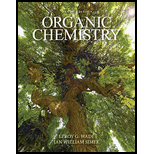
Concept explainers
(a)
Interpretation:
The compounds required for the condensation to synthesise the given compound are to be stated.
Concept introduction:
In base-catalysed aldol condensation, nucleophilic addition of an enolate ion takes place on a carbonyl group. In first step, an alpha proton is removed to produce enolate ion. It adds to the carbonyl group. In the next step, protonation of alkoxide gives the aldol product.
(b)
Interpretation:
The compounds required for the condensation to synthesise the given compound are to be stated.
Concept introduction:
Michael addition is a conjugate addition or 1,4-addition of a resonance stablised carbanion to a conjugated double bond. The conjugate double bond of
(c)
Interpretation:
The compounds required for the condensation to synthesis the given compound are to be stated.
Concept introduction:
Michael addition is a conjugate addition or 1,4-addition of a resonance stablised carbanion to conjugated double bond. The conjugate double bond of
Want to see the full answer?
Check out a sample textbook solution
Chapter 22 Solutions
Organic Chemistry Plus Mastering Chemistry with Pearson eText -- Access Card Package (9th Edition) (New in Organic Chemistry)
- a. H3C CH3 H, 1.0 equiv. Br2arrow_forwardH3C. H3C CH 3 CH 3 CH3 1. LDA 2. PhSeCl 3. H2O2arrow_forwardPlease predict the products for each of the following reactions: 1.03 2. H₂O NaNH, 1. n-BuLi 2. Mel A H₂ 10 9 0 H2SO4, H₂O HgSO4 Pd or Pt (catalyst) B 9 2 n-BuLi ♡ D2 (deuterium) Lindlar's Catalyst 1. NaNH2 2. EtBr Na, ND3 (deuterium) 2. H₂O2, NaOH 1. (Sia)2BH с Darrow_forward
- in the scope of ontario SCH4U grade 12 course, please show ALL workarrow_forwardIs the chemical reaction CuCl42-(green) + 4H2O <==> Cu(H2O)42+(blue) + 4Cl- exothermic or endothermic?arrow_forwardIf we react tetraethoxypropane with hydrazine, what is the product obtained (explain its formula). State the reason why the corresponding dialdehyde is not used.arrow_forward
- drawing, no aiarrow_forwardIf CH3COCH2CH(OCH3)2 (4,4-dimethoxy-2-butanone) and hydrazine react, two isomeric products are formed. State their structure and which will be the majority.arrow_forward+ Reset Provide the correct IUPAC name for the compound shown here. 4-methylhept-2-ene (Z)- (E)- 1-6-5-2-3-4- cyclo iso tert- sec- di tri hept hex oct meth eth pent ane yne ene ylarrow_forward
 Organic Chemistry: A Guided InquiryChemistryISBN:9780618974122Author:Andrei StraumanisPublisher:Cengage Learning
Organic Chemistry: A Guided InquiryChemistryISBN:9780618974122Author:Andrei StraumanisPublisher:Cengage Learning
